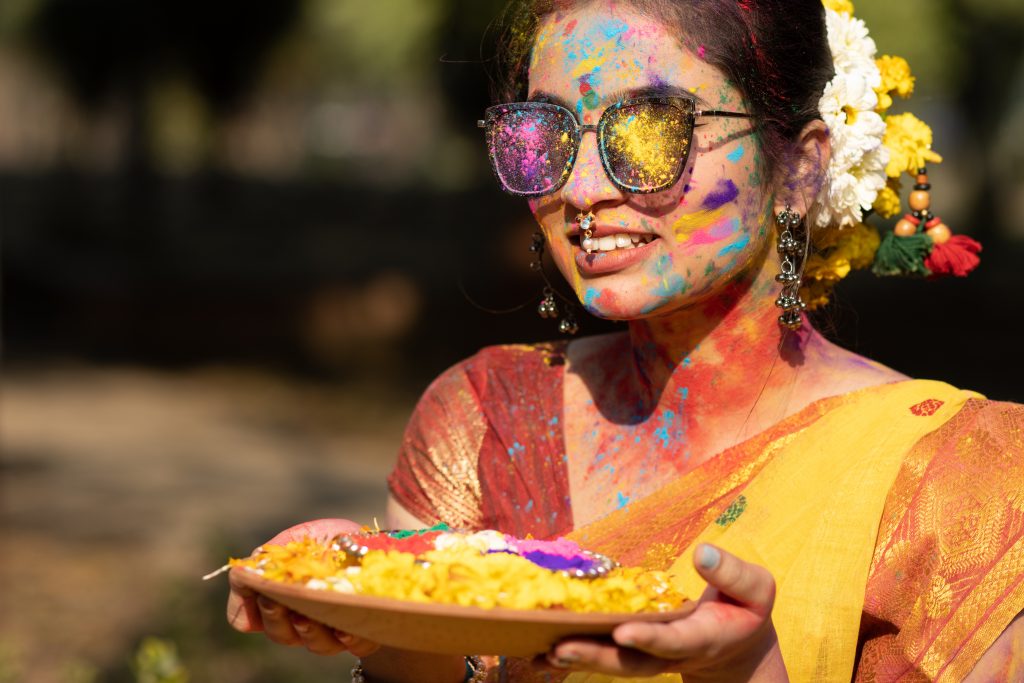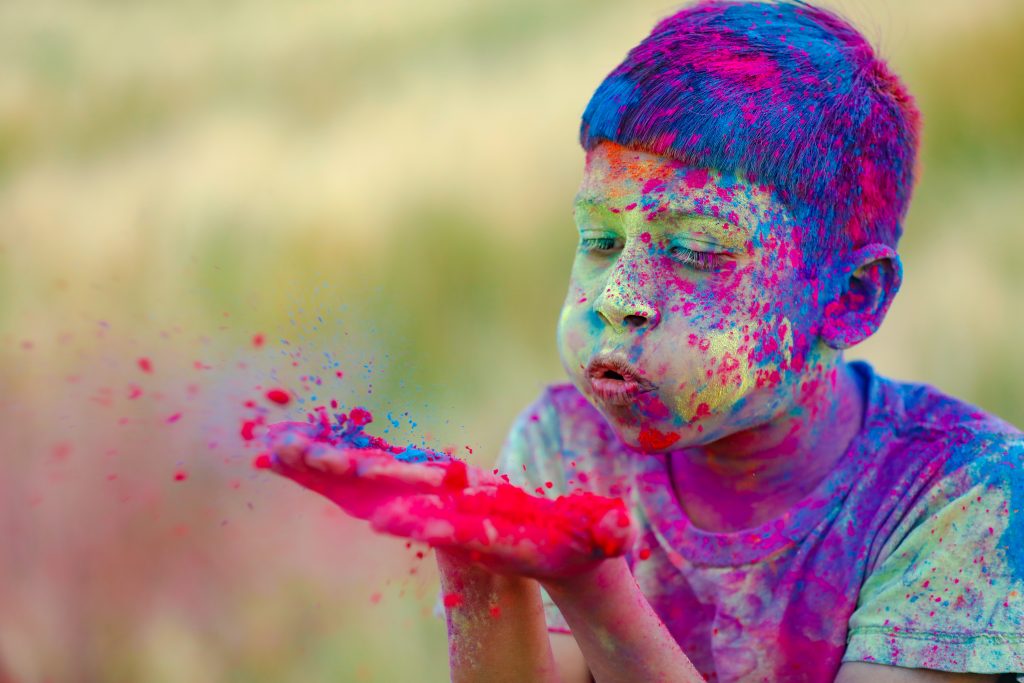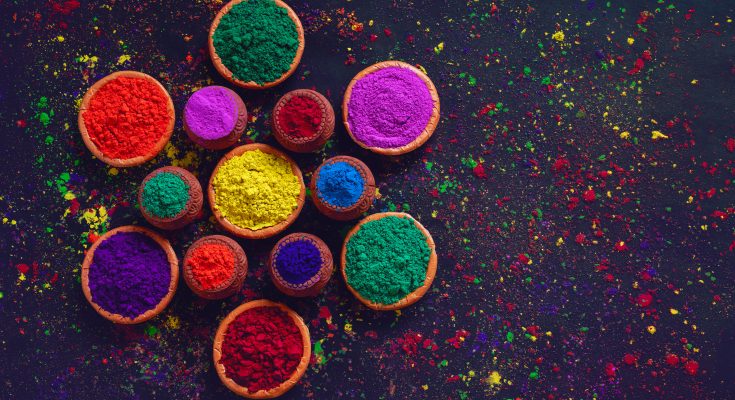The three essays on Holi explore the festival’s global significance, cultural practices, and its representation of unity and renewal. They delve into Holi’s origins in Hindu mythology, its celebration with colours and bonfires, and its role in breaking social barriers, fostering community, and symbolising the triumph of good over evil. The essays also highlight Holi’s growing popularity worldwide, transcending cultural boundaries to become a universal celebration of joy, love, and new beginnings.
Table of Contents
Holi: A Global Festival of Unity and Renewal – 1200 Words Essay
Holi, renowned as the “Festival of Colors,” stands out as one of the most exuberant and spirited festivals in the Hindu calendar. Celebrated with great zest across India and Nepal, this festival heralds the arrival of spring, symbolising the victory of good over evil and the rebirth of nature. It’s a time when the air is a canvas, splashed with vibrant colours, reflecting the joy and vitality of life itself.
However, the essence of Holi transcends its religious beginnings. It has blossomed into a global phenomenon embodying themes that resonate across cultures – unity, joy, and the rejuvenation of relationships. This evolution from a traditional Hindu festival to a worldwide celebration of human connection highlights its universal appeal and cultural significance.
Holi invites us to embrace the philosophy that “Life is the most colourful festival, and enjoy it in full spectrum.” This aphorism captures the very soul of Holi – a festival that doesn’t just colour the skin but weaves a rainbow into the fabric of our shared human experience.
Historical and Mythological Origins
The enchantment of Holi is deeply entwined with intriguing mythological tales, each adding layers of meaning to this vibrant festival. Central to Holi’s celebration is the legend of Hiranyakashipu, a powerful but arrogant demon king, his devout son Prahlad, and the malevolent aunt Holika. Hiranyakashipu’s growing disdain for his son’s unwavering devotion to Lord Vishnu culminated in a sinister plot with Holika. Endowed with a boon to resist fire, Holika sat with Prahlad in a pyre, intending his destruction. However, in a divine twist, it was Prahlad who emerged unscathed, protected by his devotion, while Holika was consumed by the flames. This story symbolises the triumph of good over evil and faith over arrogance, forming the core narrative that shapes Holi’s ethos.
Equally captivating is the tale of Radha and Krishna, an epitome of divine love and joy. Krishna, often depicted with blue skin, was self-conscious about his complexion and playfully coloured Radha’s face to overcome their differences. This act, brimming with affection and mischief, is commemorated during Holi, underscoring themes of love, acceptance, and the beauty of diversity.
These narratives not only add a mythical dimension to Holi but also convey profound moral and spiritual lessons. They emphasise virtues such as devotion, righteousness, and the power of love, echoing through the festival’s exuberant celebrations.
Holi as a Cultural Phenomenon
Holi’s charm lies not just in its mythological roots but also in its rich cultural practices. The festival begins with Holika Dahan, a ceremonial bonfire on the eve of Holi. This ritual signifies the burning away of evil and negativity, mirroring the legend of Holika. Communities gather around these fires, singing, dancing, and invoking positive energies, setting the stage for the revelry to follow.
The next day, Rangwali Holi, is where the true spirit of the festival unfolds. Streets burst into a kaleidoscope of colours as people of all ages engage in the playful throwing of gulal (coloured powders) and splashing water. Each colour holds significance: red symbolises love and fertility, blue represents the divine, green stands for new beginnings, and yellow, the colour of turmeric, signifies health. This vivid display is not merely an act of fun but a profound expression of equality and freedom, where social norms are relaxed, and joy is shared uninhibitedly.
An integral part of Holi’s cultural fabric is its culinary delights. Traditional sweets like gujiya (a sweet dumpling), and beverages like thandai (a spiced milk drink), play a crucial role in the festival. These dishes, prepared in homes and shared among neighbours and friends, foster a sense of community and belonging. The act of sharing food during Holi transcends mere consumption, weaving a tapestry of communal harmony and goodwill.
Social Dimensions of Holi
Holi’s vibrant canvas extends beyond mere celebration, playing a crucial role as a social leveller. In a society often segmented by caste, class, age, and gender, Holi emerges as a powerful equaliser. During this festival, societal norms and hierarchies temporarily dissolve. The act of smearing colours on each other, regardless of one’s social standing, fosters a sense of equality and brotherhood. Elders and youngsters, rich and poor, men and women, all participate in a shared space of joy and playfulness, reflecting a world where differences are celebrated and not just tolerated.
Furthermore, Holi serves as a profound time for reconciliation and healing. It is an occasion where people are encouraged to forgive past grievances and renew strained relationships. The festival’s ethos prompts individuals to reach out to others, mend broken bonds, and strengthen existing ones. This aspect of forgiveness and renewal is deeply ingrained in Holi’s spirit, making it not just a festivity of colours, but also a celebration of renewed relationships and emotional cleansing.
Globalisation of Holi
The allure of Holi has crossed geographical boundaries, making it a globally recognized and celebrated event. The festival’s spread beyond the Indian subcontinent is a testament to its universal appeal. Countries across the world, from the United States to Europe and Southeast Asia, host Holi events, attracting people of diverse ethnicities and cultures. These global celebrations often maintain the core traditions of Holi while integrating local cultural elements, showcasing a beautiful blend of cross-cultural exchange.
The Indian diaspora has played a pivotal role in this globalisation. As people from India settled in different parts of the world, they brought with them their traditions and festivals, including Holi. Over time, these celebrations have evolved from close-knit community gatherings to large, inclusive events, inviting people from all backgrounds to partake in the festivities.
Holi as a Metaphor for Unity and Renewal
At its heart, Holi transcends the boundaries of a traditional festival, embodying themes that resonate universally. It is a metaphor for unity, illustrating how shared joy and celebration can bridge the deepest of divides. In a world often fragmented by differences, Holi presents a model for global unity and understanding. It demonstrates how a simple act of coming together, sharing colours, can be a powerful expression of human connection.
Moreover, Holi symbolises the renewal of the human spirit. It is a reminder that life, much like the seasons, is cyclic, and each cycle brings an opportunity for rejuvenation and change. In celebrating Holi, people embrace the possibility of new beginnings, not just in their external environment but within themselves. It’s a time to shed past burdens, embrace the present’s vibrancy, and look forward to a future filled with hope and colour.
In essence, Holi is not merely a festival; it is a vivid tapestry of life itself. It paints a world where joy knows no bounds, and unity transcends all barriers. As we embrace the colours of Holi, we embrace the diverse hues of humanity, celebrating our shared spirit in a symphony of colour and camaraderie. This festival, with its global resonance and profound symbolism, reminds us that at the core, we are all part of one vibrant, interconnected community.
In the spirit of Holi, let us carry its message beyond the day of celebration: “रंगों का यह त्यौहार, लाए हर चेहरे पर बहार” (This festival of colors brings joy to every face). May the vibrancy of Holi colour not just our faces but also our hearts with love, unity, and the courage to begin anew.
Also Check – Essay on Dussehra
Essay About Holi – 150- 200 words Essay

Holi: Colors of Unity and Renewal
Holi, popularly known as the “Festival of Colors,” is a vibrant celebration deeply rooted in Hindu mythology, symbolising the triumph of good over evil. This festival, primarily observed in India and Nepal, brings an explosion of colours, signifying joy, forgiveness, and the arrival of spring. The story central to Holi’s origin involves the demon king Hiranyakashipu, his son Prahlad, a devout follower of Lord Vishnu, and Holika, the king’s sister. The miraculous survival of Prahlad from the fire, while Holika perishes, underlines the festival’s core message: the power of devotion overcoming the strength of adversity.
Holi is not just a display of playful colour-throwing; it’s a time when barriers of age, gender, and social status blur, fostering a spirit of unity and renewal. The night before Holi, bonfires are lit, symbolising the burning of evil. The following day, people joyously smear each other with coloured powders, dance under water sprinklers, and share sweets. This jubilant atmosphere creates a sense of belonging and community, transcending cultural and social boundaries.
Embraced globally, Holi’s celebration extends beyond the Indian diaspora, inviting people worldwide to experience its universal message of love, forgiveness, and the joyous renewal of life.
Also Check – Diwali Essay Collection
Essay About Holi – 500 – 700 Words Essay
Colours of Unity: Celebrating Holi’s Global Essence

Holi, often referred to as the “Festival of Colors,” is a prominent and colourful festival celebrated mainly in India and Nepal, with increasing popularity across the globe. This festival, rich in cultural significance and historical roots, is not just a celebration of colours but also a commemoration of the triumph of good over evil, the onset of spring, and a time for forgiveness and new beginnings.
The origin of Holi is deeply embedded in Hindu mythology and revolves around several legends, the most prominent being the story of Hiranyakashipu, a powerful and arrogant demon king who desired to be worshipped as a god. His son, Prahlad, however, remained a devout follower of Lord Vishnu, much to his father’s fury. Hiranyakashipu’s attempts to harm Prahlad were thwarted by Lord Vishnu’s protection. The culmination of this story is the burning of Holika, the king’s sister, who was immune to fire but perished when she tried to burn Prahlad on her brother’s orders. Miraculously, Prahlad survived, exemplifying the victory of faith and goodness.
Another legend associated with Holi is the immortal love story of Radha and Krishna. Krishna, who had a dark complexion, playfully painted Radha’s face with colours to overcome their complexion difference, a scene that has become a symbolic expression of love during Holi. This legend reinforces the festival’s theme of love and unity, transcending superficial barriers.
The celebration of Holi is spread over two days. The first evening, known as Holika Dahan, involves lighting bonfires, symbolising the burning away of evil spirits and the triumph of good. People gather around the fire, perform rituals, and pray for the destruction of their internal evils.
The following day is Rangwali Holi, the more recognized aspect of the festival, where the play with colours takes place. Streets, parks, and open spaces become arenas for people to throw and smear vibrant coloured powders, known as ‘gulal,’ on each other. Water balloons and water guns add to the playful atmosphere. This act of colouring not only represents the vibrant hues of spring but also breaks down social barriers. During Holi, distinctions of age, gender, status, and caste dissolve, fostering a spirit of equality and togetherness.
Culinary delights are a significant part of the celebration, with traditional sweets like ‘gujiya,’ ‘thandai,’ a spiced milk drink, and other festive foods being shared among friends and family. These treats symbolise sharing joy and sweetness in relationships.
Beyond India, Holi has gained popularity in various parts of the world, celebrated by Indian diaspora communities and increasingly embraced by people of different cultures and ethnicities. This global adoption of Holi speaks to its universal themes of love, unity, and the rejuvenation of life. In many cities around the world, “Colour Runs” and “Holi Festivals” are organised, drawing participants from diverse backgrounds to experience the joy and unity that Holi symbolises.
In conclusion, Holi is more than just a festival of colours; it’s a celebration of life, a reminder of the enduring power of faith and goodness, and a testament to the joy that comes from unity and renewal. It encourages people to set aside their differences, embrace forgiveness, and celebrate life in its most vivid and colourful forms. As the world becomes more interconnected, Holi’s message of unity and joy continues to resonate globally, making it a true celebration of humanity in all its diversity.



